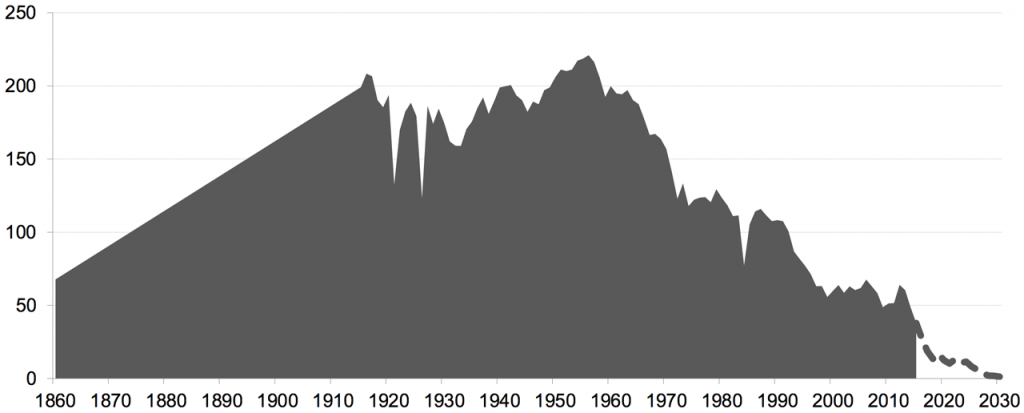The Rise and Fall of Coal in 7 Stories

1. Andreas Malm, Fossil Capital: The Rise of Steam Power and the Roots of Global Warming (2016)
“The fossil economy has one incontestable birthplace: Britain accounted for 80 percent of the global emissions of CO2 from fossil fuel combustion in 1825 and and 62 percent in 1850. . . . Britain . . . continued to generate more than half of the world’s emissions far into the nineteenth century. The origins of our predicament must be located on British soil.” (13)
“By 1800, most of the smoke from British coal combustion still left fairly small chimneys. . . . Combustion had yet to be decoupled from population, and so Britain could not be said to have constituted a fossil economy proper. By 1850, all that had changed. . . . By 1870, three times more coal was burnt in general manufacturing, iron and steel than in the hearths and homes of Britain, the fires decoupled from population growth and linked to self-sustaining economic growth.” (249-250).
Book details here »
2. “Wind and Solar are Crushing Fossil Fuels” (April 6, 2016)
The world's first coal superpower, the U.K., now produces less power from coal than it has since at least 1850.” (Bloomberg News) Article here »

3. “Solar power sets new British record by beating coal for a day” (April 13, 2016, The Guardian)
The sun provided British homes and businesses with more power than coal-fired power stations for 24 hours last weekend. While solar power has previously beaten coal for electricity generation over a few hours in the UK, Saturday was the first time this happened for a full day. Analysts said the symbolic milestone showed how dramatic coal’s decline had been due to carbon taxes, as solar had “exploded” across the UK in recent years. Article here »
4. Peabody Energy, a Coal Giant, Seeks Bankruptcy Protection (April 13, 2016, New York Times)
The collapse in natural gas prices over the last three years and new environmental regulations by the Obama administration have led to a rapid decline of the industry, especially in the Appalachia region, where mines are deep and expensive to operate. Domestic production last year slumped to a three-decade low. Coal was once the provider of roughly half of the nation’s power, but it was surpassed by natural gas as the No. 1 source of electricity for the first time a year ago. The Paris climate agreement signed in December has convinced many investors that the coal industry is in a death spiral. At the same time, there is a glut of coal on global markets, in part because of uneven economic growth in Europe and emerging markets. Article here »
5. The day coal power dropped out of the UK’s national grid for the first time in more than 100 years (The Independent, May 22, 2016)
At midnight on 10 May 2016, the UK hit an energy milestone. For the first time in over 100 years, the amount of coal being used by the national grid to power Britain’s kettles, computer and televisions fell to zero. And then it stayed at zero for four hours. The Independent, United Kingdom. Article here »
6. Solar power breaks UK records thanks to sunny weather (The Guardian, May 29, 2017)
Thousands of photovoltaic panels across the UK generate 8.7GW, smashing previous high of 8.48GW earlier this month . . . The milestone reached on Friday is the latest in a series of records for solar, which has grown from almost nothing seven years ago to 12GW of capacity today. Last summer it provided more power than the UK’s last 10 coal-fired power stations. Article here
7. U.S. Renewable Energy Jobs Employ 800,000+ People and Rising (Inside Climate News, May 30, 2017)
Twice as many Americans now work in the wind industry as in coal mining, and solar employs many more, but the U.S. still trails the EU and is far behind China. Article here


